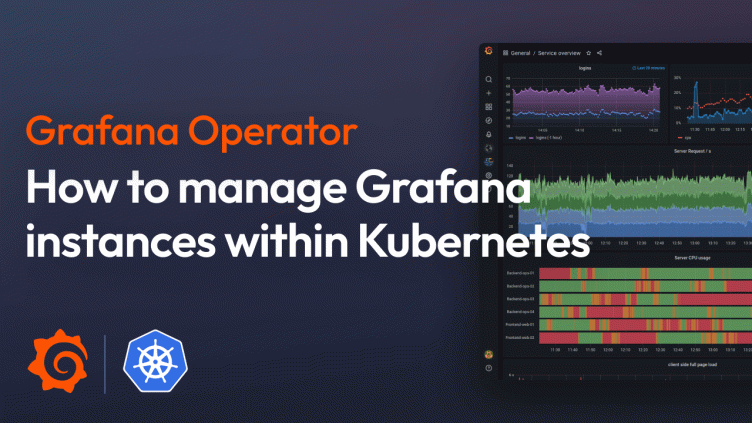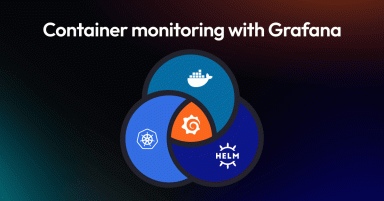
How to manage Grafana instances within Kubernetes
If you’re using Grafana and Kubernetes, we’ve got exciting news — Grafana Labs will be maintaining and managing the Grafana Operator, the open source Kubernetes operator that helps you manage your Grafana instances within and outside of Kubernetes. This significant move not only elevates the Grafana Operator to an officially supported tool but also cements its place as a staple for managing Grafana as code, especially for users keen on adopting GitOps principles.
The Grafana Operator at a glance
For the uninitiated, the Grafana Operator is a Kubernetes operator you can use to manage Grafana instances and their assorted resources — dashboards, data sources, and folders — from within your Kubernetes environment. It uses the power of Kubernetes’ custom resource definitions (CRDs) to help you describe your Grafana instance and the resources declaratively, just like you would manage your applications and services in Kubernetes. This makes it an ideal fit for GitOps workflows and version-controlled infrastructure.
Why the move matters
Migrating the Grafana Operator under the official Grafana Labs umbrella brings several advantages:
- Trust and reliability: As an officially recognized component, users gain added confidence in integrating the operator into their infrastructure.
- Seamless integrations: Compatibility with Grafana Cloud and other Grafana Labs offerings becomes more streamlined when the operator is just an internal handshake away from the Grafana Labs team.
- Community and support: Having the operator under the Grafana banner paves the way for a more focused and collaborative community effort, driving better documentation, more examples, and wider adoption.
- Feature development: Direct affiliation with Grafana’s product evolution ensures that the operator remains at the cutting edge, quickly adapting new features and capabilities released by Grafana Labs.
Embracing GitOps with Grafana Operator
The GitOps methodology revolves around using Git repositories as the single source of truth for defining and controlling your software infrastructure. With the Grafana Operator now officially supported, users can fully embrace GitOps practices by managing Grafana configurations alongside their application manifests.
Consider this scenario: Using ArgoCD, a popular GitOps continuous deployment tool, you can synchronize your Grafana dashboard configurations from a Git repository directly into your Kubernetes cluster — the Grafana Operator keeps your Grafana instance updated without manual intervention. This not only promotes consistency and reliability but also enhances your ability to collaborate and audit infrastructure changes.
Getting started with the Grafana Operator
To begin using the Grafana Operator with Grafana Cloud or on-prem Grafana instances, follow these steps:
- Quick installation
The quickest way to install the Grafana Operator in your cluster is by using Helm. Run the following command in your terminal:
helm upgrade -i grafana-operator oci://ghcr.io/grafana/helm-charts/grafana-operator --version v5.6.0This command uses Helm to fetch the latest Grafana Operator chart from the specified repository and install it in your cluster. You can also specify a particular version using the –version attribute in the above command. And if there are particular configurations you want to alter, peek into the values.yaml of the Helm chart for customization options.
For other ways to install, you can look up the, refer to the Grafana Operator installation documentation.
- Navigate to the quick starts or dive into official docs
Once you’ve installed the operator, it’s time to start using it. Whether you’re a hands-on learner or someone who likes to understand all the details first, we’ve got resources for you:
Check out the quick start guides. These guides are perfect for understanding how the operator can fit into your workflow.
- This guide will take you through how to set up data sources, and create dashboards and folders, all within your Kubernetes environment.
- Want to manage dashboards with a Git-based workflow? There’s a guide for that, too! You’ll learn how to work with the Grafana Operator and tools like ArgoCD to keep your dashboards in sync.
If you prefer to have a full view of the capabilities and settings, the official Grafana Operator documentation is the place to go. It’s packed with everything you need to know about the Grafana Operator, from the basic setup to the more advanced configurations and examples.
Streamlining Grafana as code efforts
With this move, the Grafana Operator now becomes an integral tool in the Grafana as code toolkit — sitting alongside our support for tools like Terraform and Ansible. Being a Kubernetes-native solution, the operator fits exceptionally well within ecosystems already leveraging Kubernetes resources, providing a natural and efficient way to manage Grafana through familiar Kubernetes manifests.
Looking ahead
With the Grafana Operator now sporting the official Grafana Labs seal, users can look forward to tighter integration, more robust features, and a growing community of contributors all working to make managing Grafana resources as smooth and effortless as possible.
Whether you’re a DevOps engineer seeking to streamline operations, an SRE focusing on reliability through controlled deployments, or an infrastructure architect embracing GitOps principles, the Grafana Operator presents an essential addition to your observability toolkit.
The Grafana Operator ensures that managing observability infrastructure remains code-centric — maintaining a single source of truth, improving audit trails, and enabling automated, reliable, and scalable deployments. Embrace the Grafana Operator and harness the power of GitOps for your Grafana resources.
Grafana Cloud is the easiest way to get started with metrics, logs, traces, dashboards, and more. We have a generous forever-free tier and plans for every use case. Sign up for free now!



